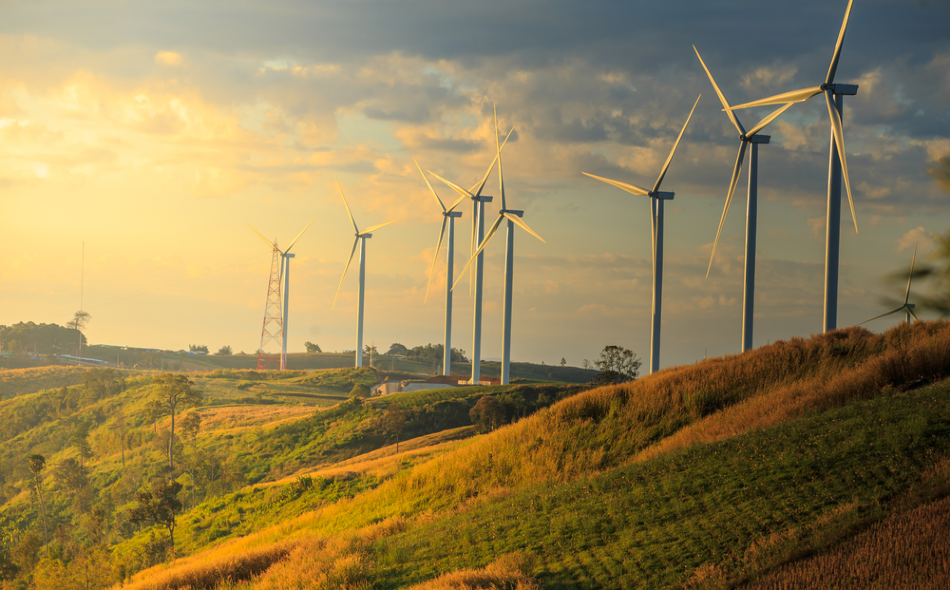May 28 2008

Image Credit: chaiviewfinder/Shutterstock.com
Article updated on 21/02/20 by Brett Smith
The wind is a clean and renewable energy source that can produce enough electricity to power millions of homes and businesses. Wind is the movement of air created by the uneven heating of the surface of the earth by the sun. Wind moves through the atmosphere with sometimes extraordinary amounts of kinetic energy.
Capturing this energy can significantly reduce human reliance on fossil fuels, as well as cutting down on harmful greenhouse gas emissions caused by burning fossil fuels.
The process by which wind is used to generate electricity is referred to as wind energy. Wind turbines convert wind's kinetic energy into mechanical power. This mechanical power can then be converted into electricity through the use of a generator.
How Wind Turbines Work
The kinetic energy of the wind is collected by the blades on the wind turbines. Similar to the wings on an aircraft, the wind flows over the airfoil-shaped blades causing lift. This, in turn, causes the turbine to turn. The turbine blades are connected to a drive shaft which turns a generator and electricity is produced. Gearing systems connected to the drive shaft ensure maximum rotations of the shaft according to the prevalent wind conditions.
.jpg)
Image Credit: Dept. of Energy
A singular cluster of wind turbines is a wind power plant, more commonly referred to as a wind farm. The proper installation of wind turbines involves more than just looking for a windy area. Studies of wind conditions and careful planning should be conducted prior to any installation.
Ideal places to build wind turbines have average wind speeds of at least 9 mph for small turbines and 13 mph for large utility-scale turbines. Typically, these places are the tops of rounded hills, plains and open water. Sometimes, mountain valleys that funnel and intensify blowing wind are also used for installation sites.
Types of Wind Turbines
Today's wind turbines fall into two main categories based on the direction of the rotating shaft.
The most common type of wind turbines used today is the horizontal-axis wind turbines. Horizontal-axis wind turbines have turbine blades that look like airplane propellers, with large utility-scale turbines usually having three blades. The biggest horizontal axis turbines are the same height as a 20-storey building and have blades greater than 100 feet in length. As a general rule of thumb, the longer the blades, the more electricity a turbine can produce.
Much less common than horizontal-axis turbines, vertical–axis wind turbines have blades that look like a kitchen egg-beater or whisk. The most common type of vertical axis wind turbine is known as the Darrieus wind turbine, which is named after George Darrieus, the French engineer who patented the design in 1931. Large versions of this type of turbine stand 100 feet tall. Although they are not as efficient as horizontal-axis turbines, Darrieus turbines have gained attention recently as a better way to capture wind energy in floating, offshore wind farms.
They are also used on the tops of buildings or in smaller-scale renewable energy systems.
.jpg)
Image Credit: Dept. of Energy
Size of Wind Turbines
The size of a wind turbine differs widely. Small turbines are used to provide power to a single home or business, often with capacities under 100 kilowatts. Larger commercial-sized wind turbines can have a capacity ranging from hundreds of kilowatts to several megawatts. These larger turbines are frequently grouped into wind farms providing power to the electricity grid. Offshore wind turbines located in water on a continental shelf are typically bigger than land-based turbines and are capable of generating more power as a result.
.jpg)
Image Credit: Dept. of Energy
Wind Energy and the Environment
Wind energy is a clean source of energy that can be produced domestically. Being fuelled by the wind, wind energy does not pollute the air or produce any atmospheric emissions while generating electricity.
The main challenge facing wind energy is the intermittency of wind, where it does not always blow when power is required. Wind energy must also compete on a cost basis with conventional generation sources such as fossil fuels.
One key metric used to gauge the production of wind energy is the capacity factor. This metric indicates the amount of electricity produced over a given time period, typically the length of one year, compared to its maximum potential. The typical wind turbine produces useful quantities of electricity more than 90% of the time.
Because of wind energy’s many benefits, countries around the world have to support the development of wind farms. As of 2016, more than 950 billion kilowatt-hours of wind energy was being generated in 128 countries. Europe and the United States are where the vast majority of wind installations are located. China and India significantly increased wind capacity in recent years, and both recently cracked the top five countries in terms of electricity generated from wind.
It should be noted that wind turbines are not completely without fault when it comes to environmental impact. Critics have argued that massive wind turbines are unnatural and negatively impact the visual appeal of the landscape. Wind turbines also generate noise that can be unpleasant.
The one criticism that has perhaps gained the most traction is the fact that wind turbines do kill significant amounts of birds and bats. The mortality rates of these flying animals can contribute to population declines. Researchers are currently looking into ways to minimize this negative environmental impact of winter turbines.
References and Further Reading